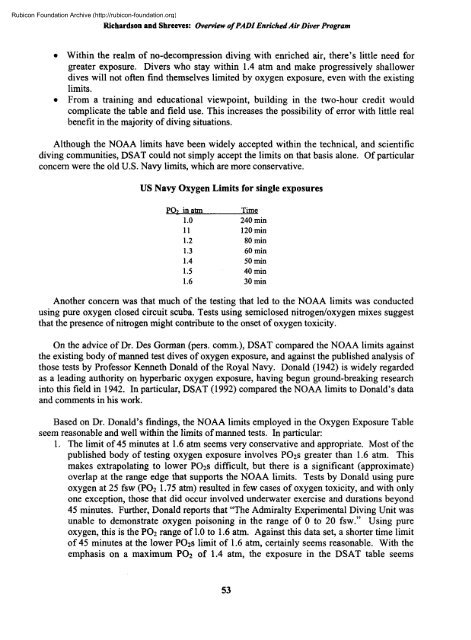Rubicon Foundation Archive (http://rubicon-foundation.org)Richardson and Shreeves: Overview of PADI Enriched Air Diver Program• Within the realm of no-decompression diving with enriched air, there's little need forgreater exposure. <strong>Divers</strong> who stay within 1.4 atm and make progressively shallowerdives will not often find themselves limited by oxygen exposure, even with the existinglimits.• From a training and educational viewpoint, building in the two-hour credit wouldcomplicate the table and field use. This increases the possibility of error with little realbenefit in the majority of diving situations.Although the NOAA limits have been widely accepted within the technical, and scientificdiving communities, DSAT could not simply accept the limits on that basis alone. Of particularconcern were the old U.S. Navy limits, which are more conservative.US Navy Oxygen Limits for single exposuresPOj in atm1.0111.21.31.41.51.6Time240 min120 min80 min60 min50 min40 min30 minAnother concern was that much of the testing that led to the NOAA limits was conductedusing pure oxygen closed circuit scuba. Tests using semiclosed nitrogen/oxygen mixes suggestthat the presence of nitrogen might contribute to the onset of oxygen toxicity.On the advice of Dr. Des Gorman (pers. comm.), DSAT compared the NOAA limits againstthe existing body of manned test dives of oxygen exposure, and against the published analysis ofthose tests by Professor Kenneth Donald of the Royal Navy. Donald (1942) is widely regardedas a leading authority on hyperbaric oxygen exposure, having begun ground-breaking researchinto this field in 1942. In particular, DSAT (1992) compared the NOAA limits to Donald's dataand comments in his work.Based on Dr. Donald's fin<strong>dings</strong>, the NOAA limits employed in the Oxygen Exposure Tableseem reasonable and well within the limits of manned tests. In particular:1. The limit of 45 minutes at 1.6 atm seems very conservative and appropriate. Most of thepublished body of testing oxygen exposure involves PO2S greater than 1.6 atm. Thismakes extrapolating to lower PO2S difficult, but there is a significant (approximate)overlap at the range edge that supports the NOAA limits. Tests by Donald using pureoxygen at 25 fsw (PO2 1.75 atm) resulted in few cases of oxygen toxicity, and with onlyone exception, those that did occur involved underwater exercise and durations beyond45 minutes. Further, Donald reports that "The Admiralty Experimental Diving Unit wasunable to demonstrate oxygen poisoning in the range of 0 to 20 fsw." Using pureoxygen, this is the PO2 range of 1.0 to 1.6 atm. Against this data set, a shorter time limitof 45 minutes at the lower PO2S limit of 1.6 atm, certainly seems reasonable. With theemphasis on a maximum PO2 of 1.4 atm, the exposure in the DSAT table seems53
Rubicon Foundation Archive (http://rubicon-foundation.org)Lang (ed.): DAN<strong>Nitrox</strong> Workshop, <strong>Divers</strong> <strong>Alert</strong> <strong>Network</strong>, November 2000appropriate. The time limits for PO2S below 1.4 atm stem more from pulmonary oxygentoxicity concerns than from CNS (acute) toxicity (Hamilton, 1989). An analysis of theexposure limits on the DSAT table when calculated as Oxygen Tolerance Units (OTUs)shows a maximum of approximately 300 OTUs at a PO2 of 1.0 atm., which conformswith the daily OTU dose recommended by the Repex oxygen exposure limits for repeateddaily exposure to oxygen. (Kenyon and Hamilton, 1988).2. Dr. Donald discounts the old Navy limits as unrealistically conservative. In Oxygen andthe Diver, he says "... Time limits were also given from 30 minutes at 1.6 atm to 240minutes at 1.0 atm. These time limits appear to have been quite arbitrary and unrelatedto acute or pulmonary oxygen poisoning... These restrictions cause a considerablelimitation in the scope of mixture diving..." According to Dr. Donald, the Navy limitsmay have resulted because tests by Lanphier (1954) seemed to show a possible reductionin oxygen tolerance when breathing nitrogen/oxygen mixtures.3. Dr. Donald doesn't believe the evidence supports the notion that nitrogen/oxygenmixtures increase the probability of oxygen toxicity. He cites the limited data thatLanphier based his conclusion on, and further cites experiments that show that nitrogenhas neither a positive nor negative effect (Dickens, 1945). Says Donald, "Thus[Lanphier's] total evidence that, contrary to the Royal Naval fin<strong>dings</strong> (Donald, 1943 (i)& (ii)) and experience, oxygen was more toxic when breathed in oxygen-nitrogenmixtures is of little formal significance."4. A more recent question involves the role of carbon dioxide retention in causing oxygentoxicity. Although few individuals retain carbon dioxide, especially when usingconventional open circuit scuba equipment, recent tests support the limit of 1.4 atm asappropriate when an individual's carbon dioxide retention isn't known. (Kerem et al,1995).Field data support both the limits and Dr. Donald's research and experience. The NOAAlimits have been in use for more than a decade, with virtually no incidence of oxygen toxicityreported within the proposed range. With the additional conservatism built in, the DSATOxygen Exposure Table appears to be well suited for use by recreational divers.Computer Dives Using Enriched AirThe optimum method for diving enriched air with a computer is to use an enriched aircomputer. Following the manufacturer's instructions, you program these computers with theblend you're using, they track your no-decompression status and oxygen exposure. If youalready own an air dive computer, you can use enriched air with it, too. The simplest way is toplan your dive as a standard single depth enriched air dive using EADs and tables. Then, makeyour dive with your air computer. During the dive, you can use whichever gives you more nodecompressiontime, your computer or the EADs and tables. Remember, however, thatrepetitive dives must be calculated based on what you follow in the first dive.It's important to plan and track oxygen exposure, especially for long multilevel dives.Planning dives so you ascend in levels, calculating each level's oxygen exposure separately andadding them together. Start at the deepest point of your dive and progressively work shallower,54
















